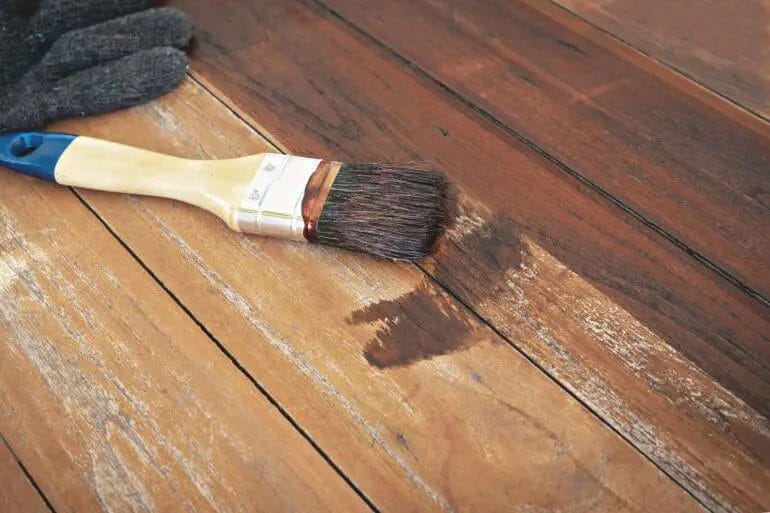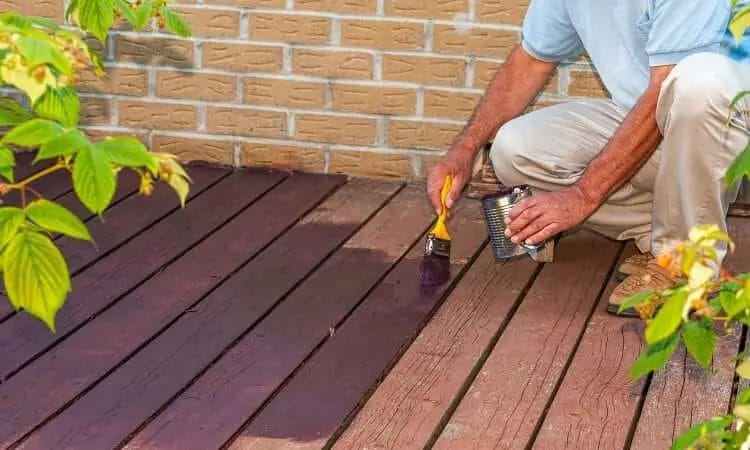If you’ve recently applied a stain to wood, you’re probably wondering how long it will take to dry. The drying time of a stain on wood can vary depending on several factors. These include the type of stain used, the humidity level in the environment, and the thickness of the applied layer. In general, oil-based stains can take anywhere from 8 to 24 hours to dry, while water-based stains may dry within 1 to 3 hours. It’s important to allow the stain ample time to dry before applying any additional coats or finishing touches.

Factors Affecting Drying Time of Wood Stain: What to Consider
Wood staining is a popular method of enhancing the beauty and durability of wooden surfaces. Whether you are staining a piece of furniture, a deck, or a wooden floor, one important aspect to consider is the drying time of the wood stain. The drying time can vary depending on several factors, and understanding these factors is crucial for achieving the desired results. In this section, we will explore the key factors that affect the drying time of wood stain and what you should consider.

Type of Wood
The type of wood being stained is one of the primary factors that influence the drying time of wood stain. Different wood species have varying levels of porosity, which directly affects how quickly the stain is absorbed and dries. Softwoods, such as pine or spruce, typically have larger pores and tend to absorb stain more quickly than hardwoods like oak or mahogany. It is essential to consider the type of wood you are working with to estimate the drying time accurately.
Humidity and Temperature
Humidity and temperature play a significant role in the drying process of wood stain. High humidity levels can prolong the drying time as the excess moisture in the air slows down the evaporation of solvents in the stain. On the other hand, low humidity can accelerate drying but may also lead to faster evaporation, resulting in uneven or blotchy finishes. Similarly, temperature affects drying time, with higher temperatures generally promoting faster drying. It is crucial to check the weather conditions and choose an optimal time for staining to ensure proper drying.
Application Thickness
The thickness of the applied wood stain can impact the drying time. If the stain is applied too thickly, it will take longer to dry as the excess stain needs more time to evaporate. Conversely, applying a thin, even coat of stain allows for faster drying. It is recommended to follow the manufacturer’s instructions regarding the application thickness to achieve the desired drying time and finish.
Type of Stain
The type of wood stain you choose can also affect the drying time. There are various types of wood stains available, including oil-based, water-based, and gel stains. Oil-based stains generally have a longer drying time compared to water-based stains. Gel stains, known for their thicker consistency, may require more time to dry as well. It is essential to consider the specific characteristics of the stain you are using and plan accordingly.
Ventilation
Proper ventilation is crucial for the drying process of wood stain. Sufficient airflow helps in the evaporation of solvents and speeds up the drying time. If the stained surface is in an enclosed or poorly ventilated area, it may take longer for the stain to dry. Ensure that the area where you are staining has adequate ventilation to promote efficient drying.
Summary
When staining wood, it is important to take into account the factors that can affect the drying time of the wood stain. Consider the type of wood, humidity and temperature conditions, application thickness, type of stain, and ventilation. By understanding and managing these factors, you can ensure that your wood stain dries properly, leading to a beautiful and long-lasting finish on your wooden surfaces.

Accelerating the Drying Process: Tips and Techniques for Quicker Results
Drying is an essential process in various industries, from food production to manufacturing. However, the traditional drying methods can be time-consuming, leading to delays in production and increased costs. Thankfully, there are several tips and techniques that can help accelerate the drying process, allowing for quicker results and improved efficiency. In this section, we will explore some of the most effective strategies to speed up drying times and enhance productivity.
1. Increase Airflow
One of the simplest ways to accelerate drying is to increase the airflow in the drying environment. Adequate ventilation helps remove moisture from the surface being dried, expediting the evaporation process. Consider using fans or blowers to circulate air more effectively and remove humid air. By improving airflow, you can significantly reduce drying times.
2. Control Temperature
Temperature plays a crucial role in the drying process. Higher temperatures generally lead to faster evaporation. However, it’s important to strike a balance between temperature and product integrity. Some materials may be sensitive to high temperatures and may degrade or lose quality. Therefore, it’s essential to carefully monitor and control the temperature to optimize drying speed without compromising product integrity.
3. Utilize Dehumidifiers
In environments with high humidity, using dehumidifiers can be highly effective in accelerating the drying process. Dehumidifiers remove excess moisture from the air, creating a drier environment that promotes faster evaporation. This technique is particularly useful in industries such as painting, where humidity can significantly prolong drying times. By controlling humidity levels, dehumidifiers help expedite the drying process.
4. Optimize Drying Equipment
Choosing the right drying equipment can make a significant difference in drying efficiency. Consider investing in equipment that is specifically designed for rapid drying. Look for features such as adjustable airflow, temperature control, and efficient moisture removal systems. Upgrading to advanced drying equipment can save time, enhance productivity, and improve the overall drying process.
5. Pre-Drying Preparation
Preparing the materials or products before the drying process can also help accelerate drying times. By removing excess moisture or reducing the initial moisture content, you can significantly reduce the time required for drying. Techniques such as preheating, blanching, or using centrifuges can effectively remove moisture and expedite the drying process.
6. Cut Products into Smaller Pieces
For certain materials or products, cutting them into smaller pieces can significantly speed up the drying process. By increasing the surface area exposed to air, moisture can evaporate more quickly. This technique is commonly used in food processing, where slicing fruits, vegetables, or meat into thin slices can reduce drying times and increase efficiency.
7. Consider Microwave Drying
Microwave drying is a rapidly growing technique that offers significant advantages in terms of speed and energy efficiency. By utilizing microwave radiation, moisture inside the material is heated directly, resulting in faster drying times compared to conventional methods. This technique is particularly useful for heat-sensitive materials or products that require rapid drying without compromising quality.
8. Opt for Vacuum Drying
Vacuum drying involves drying materials under reduced pressure, which lowers the boiling point of water and speeds up the evaporation process. This technique is widely used in industries such as pharmaceuticals and electronics, where delicate materials require gentle drying. Vacuum drying offers fast and efficient results while maintaining product integrity.
9. Conduct Regular Maintenance
Regular maintenance of drying equipment is crucial for optimal performance. Clean filters, remove any blockages, and ensure that all components are functioning properly. Neglected or malfunctioning equipment can lead to inefficient drying and longer processing times. By conducting regular maintenance, you can maximize the effectiveness of your drying equipment and minimize any potential downtime.
10. Monitor and Optimize Drying Parameters
Lastly, it’s important to monitor and optimize drying parameters throughout the process. Regularly check temperature, humidity levels, and airflow to ensure that they are within the desired range. By fine-tuning these parameters, you can achieve faster and more efficient drying results.
Summary
Accelerating the drying process is crucial for industries that rely on efficient and timely production. By implementing strategies such as increasing airflow, controlling temperature, utilizing dehumidifiers, optimizing drying equipment, pre-drying preparation, cutting products into smaller pieces, considering microwave or vacuum drying, conducting regular maintenance, and monitoring drying parameters, you can significantly reduce drying times and enhance

How Long Does it Take for Different Types of Wood Stains to Dry?
Wood stains are a popular choice for enhancing the natural beauty of wood surfaces. Whether you are staining a piece of furniture, a deck, or any other wooden item, it is important to understand how long it takes for the stain to dry before you can proceed with any further steps. The drying time of wood stain can vary depending on the type of stain used as well as environmental conditions. In this section, we will explore the drying times of different types of wood stains.
1. Oil-based Wood Stains
Oil-based wood stains are known for their rich color and durability. These stains consist of pigments and dyes suspended in a solvent, typically mineral spirits or turpentine. The drying time of oil-based stains can range from 6 to 24 hours, depending on factors such as temperature, humidity, and the thickness of the stain application. It is advisable to wait at least 24 hours before applying a second coat or any protective finish.
2. Water-based Wood Stains
Water-based wood stains have gained popularity in recent years due to their low odor and easy cleanup. These stains contain pigments or dyes dissolved in water. Compared to oil-based stains, water-based stains have a shorter drying time. Generally, water-based wood stains take around 2 to 4 hours to dry. However, it is recommended to refer to the manufacturer’s instructions for precise drying times as they may vary.
3. Gel-based Wood Stains
Gel-based wood stains are thick and have a consistency similar to pudding. These stains are ideal for vertical applications as they do not drip or run. Gel-based stains have a longer drying time compared to other types of stains. On average, it takes around 8 to 12 hours for gel-based stains to dry. It is important to note that the drying time may increase in colder or more humid conditions.
4. Varnish-based Wood Stains
Varnish-based wood stains combine the color of a stain with the protective properties of varnish. These stains provide a durable finish that enhances the wood’s natural grain patterns. The drying time of varnish-based stains can vary depending on the specific product. In general, varnish-based stains may take anywhere from 4 to 8 hours to dry. It is advisable to follow the manufacturer’s instructions for accurate drying times.
Factors Affecting Drying Time
While the average drying times mentioned above can serve as a guide, it is important to consider that drying times can be influenced by various factors:
- Temperature: Higher temperatures tend to speed up the drying process, while lower temperatures can prolong it.
- Humidity: High humidity levels can slow down the drying time, while low humidity levels can accelerate it.
- Wood Porosity: The type and condition of the wood can affect how quickly the stain is absorbed and dries.
- Stain Thickness: Applying a thicker layer of stain can increase the drying time.
In summary, the drying time of wood stains can vary depending on the type of stain, environmental conditions, and other factors. It is important to allow the stain to fully dry before applying any additional coats or finishes to ensure optimal results. Always refer to the manufacturer’s instructions for specific drying times and recommendations for the stain you are using.
Troubleshooting: What to Do If Your Wood Stain Takes Too Long to Dry
Wood staining is a popular technique used to enhance the natural beauty of wood and provide a protective layer. However, sometimes the staining process doesn’t go as planned, and your wood stain takes longer than expected to dry. This can be frustrating, especially if you have a project deadline or need to use the stained wood soon. In this section, we will discuss some troubleshooting tips to help you understand why your wood stain is taking too long to dry and how to fix it.
Possible Causes of Long Drying Time
- Inadequate preparation: One of the primary reasons for a wood stain taking longer to dry is inadequate preparation of the wood surface. If the surface is not properly cleaned, sanded, or free from existing finishes, the stain may struggle to penetrate and dry.
- High humidity: Humidity plays a significant role in the drying process of wood stain. If the air is too humid, the moisture in the air can slow down the drying process, resulting in a longer drying time.
- Temperature: The ambient temperature can impact how quickly the stain dries. If the temperature is too low, the stain may take longer to dry. It is best to apply wood stain in an environment with a temperature between 60-80 degrees Fahrenheit for optimal drying.
- Application thickness: Applying an excessively thick layer of wood stain can extend the drying time. It is important to follow the manufacturer’s instructions and apply the stain in thin, even coats to ensure proper drying.
- Incorrect stain type: Using the wrong type of stain for your project can result in longer drying times. Different types of stains have different drying properties, so make sure you are using the appropriate stain for the wood and project at hand.
Steps to Speed Up Drying Time
If you find yourself with a wood stain that is taking too long to dry, don’t worry. There are several steps you can take to speed up the drying process:
- Improve ventilation: Ensure that the area where you applied the wood stain has good ventilation. Opening windows or using fans can help circulate the air and speed up evaporation.
- Reduce humidity: If high humidity is causing the delay, consider using a dehumidifier or air conditioner to lower the moisture levels in the room.
- Apply heat: Gentle heat can accelerate the drying process of wood stain. You can use a heat gun or a hairdryer on a low setting to provide a warm airflow over the stained surface. Be cautious not to apply excessive heat, as it can damage the wood.
- Remove excess stain: If you applied too much stain, use a clean cloth or sponge to gently wipe off the excess. Removing the excess stain will allow for better airflow and faster drying.
- Wait it out: Sometimes, certain factors like temperature and humidity are beyond your control. In such cases, it is best to exercise patience and allow the stain to dry naturally. Avoid touching or moving the stained wood until it is fully dry.
By following these troubleshooting tips, you can hopefully speed up the drying time of your wood stain and achieve the desired results in a timely manner. Remember to always read and follow the instructions provided by the stain manufacturer for the best outcome.
FAQs
How long does it take for stain to dry on wood?
The drying time for stain on wood depends on various factors such as the type of stain, humidity levels, and ventilation. In general, it can take anywhere from a few hours to 24 hours for stain to dry completely. It is recommended to wait at least 24 hours before applying a second coat or sealing the stained wood.
What should I do if the stain on wood is not drying?
If the stain on wood is not drying within the expected time, it could be due to high humidity, lack of ventilation, or using an incompatible type of stain. To help the drying process, ensure proper airflow, decrease humidity if possible, and consider using a fan or dehumidifier. If the issue persists, you might need to remove the stain and start again with a different product.
Can I speed up the drying process of stain on wood?
Yes, there are a few ways to speed up the drying process of stain on wood. You can increase ventilation by opening windows or using fans, lower humidity levels using a dehumidifier, or use a drying agent specifically designed for stains. However, it is important to follow the manufacturer’s instructions and avoid rushing the process excessively, as it might affect the quality of the finish.
Conclusion:
In conclusion, the drying time of stain on wood can vary depending on various factors. Generally, it takes around 24 to 48 hours for the stain to dry completely. However, certain conditions such as humidity, temperature, and the type of stain used can affect the drying process. It is important to follow the manufacturer’s instructions and allow sufficient time for the stain to dry before handling or applying a finish. Additionally, ensuring proper ventilation in the drying area can expedite the drying process. By being patient and allowing ample time for the stain to dry, you can achieve a beautiful and long-lasting finish on your wood projects.